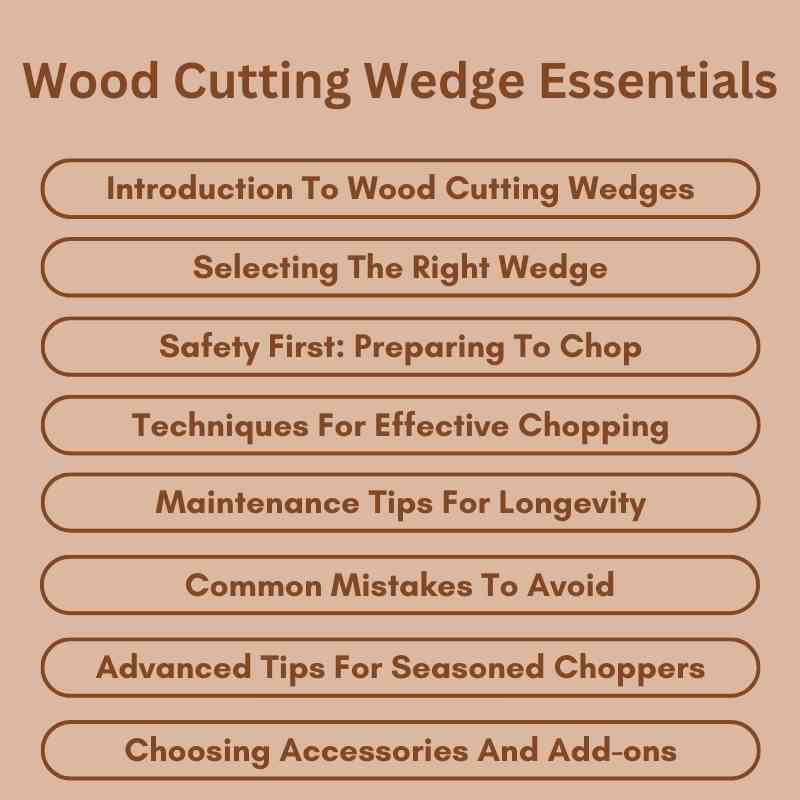A wood cutting wedge is a tool used to split wood by applying force. It creates pressure to separate logs along the grain.
Wood cutting wedges are essential for anyone working with timber, whether for firewood, construction, or crafts. These simple yet effective tools help split larger logs into manageable pieces. Made from durable materials, they feature a sharp edge that penetrates wood easily.
Using a wedge minimizes the risk of injury compared to traditional axe methods. They come in various sizes and shapes, allowing users to choose the best fit for their needs. Understanding how to use a wood cutting wedge effectively can enhance productivity and safety in any woodcutting project. Embrace this indispensable tool for efficient wood splitting.
Introduction To Wood Cutting Wedges
Wood cutting wedges are essential tools in forestry and woodworking. They help split wood quickly and efficiently. Understanding their history, types, and uses can improve your cutting skills.
History And Evolution
Wood cutting wedges date back to ancient times. Early humans used simple wedges made from stone and wood.
Over the years, materials and designs evolved. Modern wedges now use durable metals and innovative shapes.
Key milestones in the evolution include:
- Stone wedges in prehistoric times.
- Wooden wedges in early woodworking.
- Metal wedges in the 19th century.
- Modern ergonomic designs for comfort.
Types And Uses
Different types of wood cutting wedges serve various purposes. Here are common types:
| Type | Material | Use |
|---|---|---|
| Splitting Wedge | Steel | Splitting logs for firewood. |
| Felling Wedge | Plastic | Preventing trees from pinching saws. |
| Wedge and Maul | Metal | Heavy-duty splitting tasks. |
Uses of wood cutting wedges include:
- Assisting in log splitting.
- Facilitating tree felling.
- Improving safety while cutting.
- Enhancing efficiency in woodworking.
Choosing the right wedge is vital for effective wood cutting.

Selecting The Right Wedge
Choosing the right wood cutting wedge is essential for effective cutting. A suitable wedge makes the process easier and safer. Consider various factors to ensure you select the best option.
Material Considerations
The material of the wedge affects durability and performance. Here are common materials:
| Material | Advantages | Disadvantages |
|---|---|---|
| Steel | High durability, strong impact resistance | Can be heavy and prone to rust |
| Aluminum | Lightweight, resistant to corrosion | Less durable than steel |
| Plastic | Lightweight, affordable | Less effective for heavy-duty jobs |
Size And Shape For Efficiency
The size and shape of the wedge influence its effectiveness. Here are key points to consider:
- Length: Longer wedges provide more leverage.
- Width: Wider wedges split wood more effectively.
- Shape: A tapered design reduces resistance.
Choosing the right size and shape enhances cutting efficiency. Test different wedges to find what works best.
Safety First: Preparing To Chop
Chopping wood can be fun and rewarding. Safety is the top priority. Proper preparation helps avoid accidents. Follow these tips to stay safe while using a wood cutting wedge.
Personal Protective Equipment
Wearing the right gear protects you during wood cutting. Here’s a list of essential Personal Protective Equipment (PPE):
- Safety Goggles: Protects your eyes from flying debris.
- Hard Hat: Shields your head from falling branches.
- Ear Protection: Reduces noise from cutting tools.
- Gloves: Provides grip and protects your hands.
- Steel-Toed Boots: Protects your feet from heavy logs.
Always wear this gear before starting. It keeps you safe from injuries.
Setting Up Your Work Area
Creating a safe work area is crucial. Follow these steps for a safe setup:
- Choose a Clear Spot: Find a flat area free of obstacles.
- Check the Surroundings: Ensure no people or pets are nearby.
- Secure Your Tools: Keep tools organized and out of the way.
- Mark a Safety Zone: Use cones or flags to outline a safe area.
With a safe work area, you can focus on chopping wood. Safety is key for a successful job.
Techniques For Effective Chopping
Mastering wood chopping requires skill and precision. Using the right techniques can make your work easier and safer. Below are key methods to enhance your chopping efficiency.
The Art Of Placement
Placement of the wood cutting wedge is crucial. Proper placement helps in delivering a clean cut. Consider these tips:
- Choose a stable surface.
- Position the wedge at the center of the log.
- Ensure the wedge is secure before striking.
Correct placement reduces the risk of the wedge slipping. It also maximizes the force applied during chopping.
Angle And Force
The angle of your swing affects cutting efficiency. Use the following techniques to improve your chopping:
- Hold the axe at a 45-degree angle.
- Apply firm, controlled force while swinging.
- Follow through with your swing to ensure penetration.
Maintaining the right angle enhances cutting power. Adjust your stance to keep balance and stability.
Practice these techniques regularly. Consistent practice leads to better results.
Maintenance Tips For Longevity
To ensure your wood cutting wedge lasts, regular maintenance is essential. Proper care keeps it sharp and ready for use. Follow these tips for effective maintenance.
Cleaning And Storage
Clean your wood cutting wedge after each use. Dirt and sap can cause rust. Follow these simple steps:
- Wipe off dirt with a dry cloth.
- Use soap and water for sticky sap.
- Rinse and dry thoroughly.
Store the wedge in a dry place. Avoid damp areas to prevent rust. Use a protective cover to shield it from moisture.
Sharpening Your Wedge
A sharp wedge cuts better and requires less effort. Regular sharpening extends its life. Follow these steps to sharpen your wedge:
- Use a sharpening stone or file.
- Hold the wedge at a 30-degree angle.
- Make smooth, even strokes.
- Check the edge for sharpness.
Sharpen as needed. A dull wedge can damage wood and cause accidents. Keep it sharp for safety and efficiency.
| Cleaning Tips | Sharpening Tips |
|---|---|
| Wipe after each use | Use a sharpening stone |
| Use soap for sticky sap | Maintain a 30-degree angle |
| Store in a dry area | Check sharpness regularly |
Common Mistakes To Avoid
Using a wood cutting wedge can be tricky. Mistakes can lead to accidents or inefficiency. Here are some common pitfalls to avoid.
Incorrect Wedge Choice
Choosing the wrong wedge is a common mistake. Different types exist for various tasks. Here are key factors to consider:
- Material: Use steel for heavy logs.
- Size: Match the wedge size to the log size.
- Shape: Select a shape that fits the cut.
Using the wrong wedge can cause:
- Decreased efficiency
- Increased risk of injury
- Damage to equipment
Poor Technique And Safety Oversights
Technique plays a vital role in using wedges. Many overlook safety rules. Avoid these issues:
| Common Issues | Consequences |
|---|---|
| Improper stance | Higher chance of falling |
| Neglecting eye protection | Risk of eye injuries |
| Ignoring surroundings | Unexpected hazards |
Always use the right technique. Stay alert to your surroundings. Following safety measures keeps everyone safe.
Advanced Tips For Seasoned Choppers
Experienced wood choppers can benefit from advanced strategies. These tips enhance efficiency and safety. Mastering these techniques can improve your results significantly.
Leveraging The Environment
Use your surroundings to your advantage. The right environment can make cutting easier. Consider these points:
- Choose a stable ground: Firm and level ground prevents slips.
- Utilize natural slopes: Cut downhill for better leverage.
- Take advantage of trees: Use nearby trees for support.
- Consider wind direction: Cut with the wind to reduce risks.
Evaluate your site. Identify obstacles and adjust your strategy. A well-chosen location saves time and effort.
Combining Tools For Efficiency
Using multiple tools can speed up the process. Combine tools for the best results:
| Tool | Purpose | Best Use |
|---|---|---|
| Axe | Initial cuts | For smaller logs |
| Chainsaw | Quick cuts | For larger trees |
| Wedge | Splitting wood | After making cuts |
| Maul | Driving wedges | For large logs |
Use the axe for initial cuts. Switch to a chainsaw for larger trees. Wedges help split the wood effectively.
- Always keep your tools sharp.
- Store tools in a dry place.
- Inspect tools before use.
Combining tools effectively boosts your performance. Use the right tool for each task.
Choosing Accessories And Add-ons
Choosing the right accessories can enhance your wood cutting experience. They improve safety and efficiency. The right tools make every cut easier. Here’s a look at essential accessories for your wood cutting wedge.
Protective Cases And Carriers
Keeping your wood cutting wedge safe is crucial. A protective case prevents damage and prolongs its life.
- Material: Look for durable materials like hard plastic or nylon.
- Size: Ensure the case fits your wedge snugly.
- Portability: Choose a lightweight case for easy transport.
Some carriers come with extra pockets. These pockets can hold other essential tools. This feature adds convenience for woodworkers.
Complementary Tools For Wood Cutting
Using complementary tools increases cutting efficiency. Here are some must-have tools:
| Tool | Purpose |
|---|---|
| Chisel | Fine-tunes cuts and shapes wood. |
| Saw | For precise wood cutting. |
| Hammer | Drives wedges into wood. |
| Measuring Tape | Ensures accurate measurements. |
Each tool plays a vital role in effective wood cutting. Choose tools that complement your cutting wedge. This ensures a smoother workflow and better results.

Frequently Asked Questions
What Is A Wood Cutting Wedge?
A wood cutting wedge is a tool designed to split wood effectively. It is typically made from metal or durable plastic. The wedge is driven into the wood to help separate it along the grain. This tool is essential for log splitting and firewood preparation.
How Do You Use A Wood Cutting Wedge?
To use a wood cutting wedge, first, select the appropriate size. Place the wedge at the desired split point on the log. Use a mallet or hammer to drive it into the wood. As it penetrates, it will create a split, making your cutting task easier.
What Materials Are Wood Cutting Wedges Made From?
Wood cutting wedges are commonly made from steel or high-impact plastic. Steel wedges offer durability and strength for heavy-duty tasks. Plastic wedges are lighter and more portable, suitable for lighter wood. Choosing the right material depends on your specific woodcutting needs.
Can A Wood Cutting Wedge Damage My Tools?
If used correctly, a wood cutting wedge should not damage your tools. However, misuse, such as striking the wedge with the wrong tool, can lead to wear. Always use a hammer or mallet designed for striking wedges to maintain tool integrity.
Proper handling ensures longevity and safety.
Conclusion
Choosing the right wood cutting wedge can enhance your cutting efficiency. A quality wedge ensures safety and precision in your work. Invest in a durable option to make your tasks easier. Remember, the right tools lead to better results. Elevate your wood cutting experience with the perfect wedge today.

